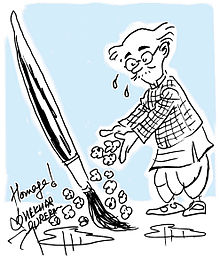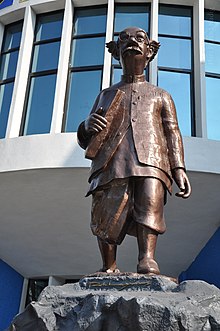R. K. Laxman
| R. K. Laxman | |
|---|---|
 |
|
| Born | Rasipuram Krishnaswami Iyer Laxman 24 October 1921 Mysuru, British India (Karnataka, India) |
| Died | 26 January 2015 (aged 93) Pune, Maharashtra, India |
| Nationality | Indian |
| Occupation | Cartoonist, illustrator |
| Known for | Common Man cartoon |
| Spouse(s) |
|
| Relatives | R. K. Narayan (brother) |
| Awards | Padma Bhushan, Padma Vibhushan, Ramon Magsaysay Award |
| Signature | |
Laxman started his career as a part-time cartoonist, working mostly for local newspapers and magazines. While a college student, he illustrated his elder brother R. K. Narayan's stories in The Hindu.[4] His first full-time job was as a political cartoonist for the The Free Press Journal in Mumbai. Later, he joined The Times of India, and became famous for The Common Man character.
Contents
R. K. Laxman was born in Mysore in 1921 and died on Jan 26,2015 .[5] His father was a headmaster and Laxman was the youngest of six sons (he had a sister as well[6]);[7] an older brother is the famous novelist R. K. Narayan. Laxman was known as "Pied Piper of Delhi".[8]
Laxman was engrossed by the illustrations in magazines such as The Strand, Punch, Bystander, Wide World and Tit-Bits, before he had even begun to read.[9] Soon he was drawing on his own, on the floors, walls and doors of his house and doodling caricatures of his teachers at school; praised by a teacher for his drawing of a peepal leaf, he began to think of himself as an artist in the making.[10] Another early influence on Laxman was the work of the world-renowned British cartoonist, Sir David Low (whose signature he misread as "cow" for a long time) that appeared now and then in The Hindu.[11] Laxman notes in his autobiography, The Tunnel of Time:
I drew objects that caught my eye outside the window of my room – the dry twigs, leaves and lizard-like creatures crawling about, the servant chopping firewood and, of course, and number of crows in various postures on the rooftops of the buildings oppositeLaxman was the captain of his local "Rough and Tough and Jolly" cricket team and his antics inspired the stories "Dodu the Money Maker" and "The Regal Cricket Club" written by his brother, Narayan.[13] Laxman's idyllic childhood was shaken for a while when his father suffered a paralytic stroke and died around a year later, but the elders at home bore most of the increased responsibility, while Laxman continued with his schooling.[14]
—R. K. Laxman[12]
After high school, Laxman applied to the J. J. School of Art, Bombay hoping to concentrate on his lifelong interests of drawing and painting, but the dean of the school wrote to him that his drawings lacked "the kind of talent to qualify for enrolment in our institution as a student", and refused admission.[15] He finally graduated with a Bachelor of Arts from the University of Mysore. In the meantime he continued his freelance artistic activities and contributed cartoons to Swarajya and an animated film based on the mythological character Narada.[16]
Career
Beginning
Laxman's earliest work was for newspapers and magazines including Swarajya and Blitz. While still at the Maharaja College of Mysore, he began to illustrate his elder brother R. K. Narayan's stories in The Hindu, and he drew political cartoons for the local newspapers and for the Swatantra. Laxman also drew cartoons for the Kannada humour magazine, Koravanji (which was founded in 1942 by Dr M. Shivaram who was an allopath and had a clinic in the Majestic area of Bangalore. He started this monthly magazine, dedicating it to humorous and satirical articles and cartoons. Shivaram himself was an eminent humourist in Kannada. He encouraged Laxman.)Laxman held a summer job at the Gemini Studios, Madras. His first full-time job was as a political cartoonist for the The Free Press Journal in Mumbai, where Bal Thackeray was his cartoonist colleague. Laxman later joined The Times of India, Bombay, beginning a career that spanned over fifty years. His "Common Man" character, featured in his pocket cartoons, is portrayed as a witness to the making of democracy.[17] Anthropologist Ritu G. Khanduri notes, "R. K. Laxman structures his cartoon-news through a plot about corruption and a set of characters. This news is visualized and circulates through the recurring figures of the mantri (minister), the Common Man and the trope of modernity symbolized by the airplane (2012: 304)."[18]
Other creations
Laxman also created a popular mascot for the Asian Paints group called Gattu in 1954.[19][20] He also wrote a few novels, the first one of which was titled The Hotel Riviera.[21] His cartoons have appeared in Hindi films such as Mr. & Mrs. '55 and a Tamil film Kamaraj. His creations also include the sketches drawn for the television adaptation of Malgudi Days[22] which was written by his elder brother R. K. Narayan and directed by Shankar Nag. Laxman also drew caricatures of David Low, T.S. Eliot, Bertrand Russell, J.B. Priestly and Graham Greene.[21]Personal life

A tribute to the late R. K. Laxman by cartoonist Shekhar Gurera
In September 2003, Laxman was affected by a stroke which left him paralysed on his left side. He partly recovered from its effects. On the evening of 20 June 2010, Laxman was admitted to Breach Candy Hospital in Mumbai after being transported by an air ambulance from Pune.[24]
In October 2012 Laxman celebrated his 91st birthday in Pune. During a private gathering at his residence, Laxman cut the cake and was presented a DVD of a documentary titled The Brainy Crow by his fan Rajvardhan Patil, depicting the life and survival of the favourite bird of the cartoonist. Shiv Sena chief Bal Thackeray, who had a past association with Laxman as a cartoonist, sent birthday greetings to him, family sources said. Scientist Jayant Narlikar and Symbiosis University chancellor S. B. Mujumdar also came to greet him on the occasion.[25]
Death
Laxman died at the age of 93 at Deenanath Mangeshkar Hospital in Pune on 26 January 2015, which incidentally happened to be India's Republic Day. He was hospitalized on 23 January for urinary tract infection and chest-related problems that ultimately led to multi-organ failure.[26] He was put on life support after his condition worsened hours before his death. He had reportedly suffered multiple strokes since 2010.[21][27][28]A cartoon that Laxman had made following the successful landing of Mangalyaan on Mars was posted by the Indian Space Research Organisation on its Facebook and Twitter pages on 27 January.[29] Maharashtra Chief Minister Devendra Fadnavis announced that Laxman would be accorded a state funeral and a memorial would be built in his honour. Laxman's body was kept at the Symbiosis Institute's Pune premises near the "Common Man" statue and his body was cremated at the Vaikunth crematorium.[30]
Laxman is survived by his wife Kamala, son Srinivas, his daughter-in-law and his grand-daughter Mahalaxmi Laxman.[31]
Awards and recognition

"The Common Man" by R K Laxman at Symbiosis Institute, Pune
- Padma Bhushan – Govt. of India – 1973[21]
- Padma Vibhushan – Govt. of India – 2005[32]
- Ramon Magsaysay Award for Journalism, Literature and Creative Communication Arts – 1984[21]
- Lifetime Achievement Award for Journalism – CNN IBN TV18 – 29 January 2008[33]
- Pune Pandit Award (Scholar of Pune Award) by the Art & Music Foundation for excellence in 'Creative Communication' – 2012[33]
- Honorary Doctorate from the University of Mysore – 2004[34]
Bibliography
- Nag, C. S. (1 October 2012). He Said It! the ... WheelMan Press. ISBN 978-0-9824361-6-5.
- Laxman, R. K. (1988). The Eloquent Brush. Times of India for Benett Coleman & Company.
- Laxman, R. K. (1998). 50 Years of Independence Through the Eyes of R.K. Laxman. The Times Group.
- Laxman, R. K. (1995). The Best of Laxman. Penguin Books.
- Laxman, R. K. (February 1989). The Hotel Riviera. Penguin Group (USA) Incorporated. ISBN 978-0-14-010796-8.
- Laxman, R. K. (1 January 1993). The messenger. Penguin.
- Laxman, R K (4 April 2002). Servants Of India. Penguin Books Limited. ISBN 978-93-5118-108-8.
- Laxman, R. K. (1 June 1998). The tunnel of time: an autobiography. Viking.
- Laxman, Rasipuram Krishnaswamy (2008). Brushing Up the Years: A Cartoonist's History of India, 1947 to the Present. Penguin Books India. ISBN 978-0-14-310366-0.
- Laxman, R K (14 October 2000). Laugh With Laxman. Penguin Books Limited. ISBN 978-93-5118-016-6.
- Laxman, R. K. (1 January 2000). Collected Writings. Penguin Books India. ISBN 978-0-14-100015-2.
- Laxman, R K (1 March 2004). Distorted Mirror. Penguin Books India. ISBN 978-0-14-303133-8.
- Laxman, R K (11 September 2002). Dose Of Laughter. Penguin Books Limited. ISBN 978-93-5118-448-5.
- His autobiography Lakshmanrekha is published in Marathi.[36]
- The Reel World [cartoons] published by Marwah Studio.
- Laxman, R. K.; Ketkar, Kumar (2000). Faces, Through the Eyes of R.K. Laxman. Bennett Coleman & Company.
- Laxman, R. K.; Ṭhakare, Baḷa; Kamath, M. V. (1999). Laughter lines: the cartoon craft of R.K. Laxman & Bal Thackery. Business Publications Inc.
- Laxman, R. K. (1975). Doodles. India Book House.
- Laxman, R. K. (1964). You said it. Times of India Press.
- Laxman, R. K. (1969). Sorry, no room. IBH Pub. Co.
- Laxman, R. K. (1990). Calcutta Images. Manjushree Foundation.
- Laxman, R. K. (1985). Madhya Pradesh, Random Sketches. Madhya Pradesh Madhyam, Directorate of Information & Publicity.
- Laxman, R. K. (2012). The Very Best of the Common Man. Penguin Books India. ISBN 978-0-14-341871-9.
- Laxman, R K (30 March 2003). Common Man Balances His Budget. Penguin Group Australia. ISBN 978-0-14-029928-1.
- Laxman, R K. Penguin India Millennium Yearbook. Penguin Books India. ISBN 978-0-670-88841-2.
- Laxman, R K (30 March 2003). Best of Laxman: Common Man Goes to the Village. Penguin Group. ISBN 978-0-14-029931-1.
- Laxman, R. K. (1970). Thama and the Little Bird. India Book House Education Trust.
- Laxman, R K. Common Man Takes A Stroll. Penguin Group. ISBN 978-0-14-029933-5.
- Laxman, R. K. (2001). Laxman Resha. ISBN 978-81-7434-128-0. OCLC 59332853.
- Laxman, R. K. (2002). Common Man Tackles Corruption. Penguin Group. ISBN 978-0-14-302804-8.
- Laxman, R. K. (1982). Science Smiles. IBH Publishing Company.
- Laxman, R. K. (2005). Laxman Rekhas. Bennett Coleman & Company. ISBN 978-81-89906-47-4.
- Rangnekar, Sharu; Aras, Kishor; Laxman, R. K.; Pama Rangnekar (1977). In the Wonderland of Indian Managers. Vikas Publ.
- Laxman, R. K. (1982). Idle Hours: Short Stories, Travelogues, Essays, Anecdotes. IBH Publishing Company.
- Laxman, R. K. (2009). R. K. Laxman: The Uncommon Man : Collection of Works from 1948 to 2008. Dharmendra Bhandari. ISBN 978-81-908606-0-4.
- Laxman, R K (1 November 2000). Penguin India Yearbook 2001. Penguin Books India. ISBN 978-0-14-100261-3.
- Mitra, Debkumar; Laxman, R.K. (1 January 2009). Penguin India Desk Companion, The - 2010. Penguin Group. ISBN 978-0-14-306718-4.
- Laxman, R K (30 March 2003). Common Man Watches Cricket. Penguin Group. ISBN 978-0-14-029932-8.
- Laxman, R. K. (1 January 2003). A Vote for Laughter. Penguin Books. ISBN 978-0-14-303086-7.
- Rangnekar, Sharu; Ṭhākara, Dineśa; Laxman, R. K. (2013). Prabandhananāṃ mūḷatattvo: In the world of corporate managersno Gujarātī anuvāda (in Gujarati). Navasarjana Pablikeśana. ISBN 978-93-81443-72-9.
- Rangnekar, Sharu; Ṭhākura, Dineśa; Laxman, R. K.; Viveka Mehetre (2010). Menejamenṭa śī rīte śīkhī śakāya tamārī patnī pāsethī. Navarsajana Pablikeśana.
Multimedia
| Wikimedia Commons has media related to R. K. Laxman. |
- India Through The Eyes of R. K. Laxman – Then To Now (CD-ROM).[37]
- R K Laxman Ki Duniya – A Television show on SAB TV.[22]
No comments:
Post a Comment